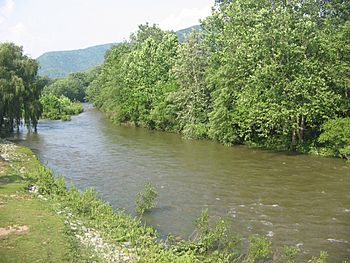Lycoming Creek facts for kids
Quick facts for kids Lycoming Creek |
|
|---|---|

Lycoming Creek at Trout Run in Lycoming County, Pennsylvania
|
|
| Country | Pennsylvania, United States |
| Physical characteristics | |
| Main source | near McNett Township, Lycoming County 2,161 feet (659 m) |
| River mouth | West Branch Susquehanna River, at Williamsport |
| Length | 37.5 miles (60.4 km) |
| Basin features | |
| Basin size | 272 square miles (700 km2) |
Lycoming Creek is a stream in Pennsylvania, USA. It is about 37.5 miles (60.4 km) long. This creek flows through Tioga and Lycoming counties. It eventually joins the West Branch Susquehanna River.
Contents
Where is Lycoming Creek?
Lycoming Creek is located in Pennsylvania. It starts in Tioga County. The creek then flows for about 25 miles (40 km) through Lycoming County. It ends when it meets the West Branch Susquehanna River in Williamsport.
Many smaller streams feed into Lycoming Creek. These include Pleasant Stream, Grays Run, Roaring Branch, Hoagland Run, and Trout Run.
What is the Lycoming Creek Watershed?
A watershed is an area of land where all the water drains into a single stream or river. Most of the Lycoming Creek watershed is in Lycoming County (about 81.5%). A smaller part is in Tioga County (16.5%). A tiny bit is in Sullivan County (1.5%).
The total area of the watershed is about 272 square miles (704 square km). In 2000, about 19,978 people lived in this area. Most of the land is covered by forests (222 square miles). Some land is used for agricultural farming (45 square miles). Only a small part is developed into towns (3 square miles).
Fun Activities on Lycoming Creek
Lycoming Creek is a great place for trout fishing. Many fish are added to the creek in the spring. This is especially true in the upper parts of the creek.
Much of the creek flows through wooded areas. You can find the Tiadaghton State Forest near Grays Run. Roads like Pennsylvania Route 14 and U.S. Route 15 run next to the creek. Near where the creek meets the river, you can find Bowman Field. This is a baseball stadium where the Williamsport Crosscutters play.
History of Lycoming Creek
Lycoming Creek was very important long ago. It was like a natural highway for early people. The local Lenape (Delaware) people called it Legani-hanne. This means "sandy stream." Over time, Europeans changed the name to Lycoming.
Native Americans and early explorers used canoes to travel on the creek. They could float down the creek to the West Branch Susquehanna River. This was much faster than walking.
Early Explorers and Conflicts
In 1737, a guide named Conrad Weiser led missionaries along the creek. They were going to Onondaga, the capital of the Iroquois Confederacy. Later, during the American Revolution, Native American warriors used the creek. They launched attacks on forts in the West Branch Susquehanna Valley.
In 1778, Colonel Thomas Hartley led soldiers up a path along the creek. This helped open the area for new settlers after the war.
Railroads and Roads
In 1839, a railroad was built along the creek. It went from Williamsport to Ralston. Later, it was extended all the way to Elmira, New York. This railroad helped transport goods and people. Over the years, the railroad changed owners. Eventually, it was abandoned in 1986. Today, U.S. Route 15 and Pennsylvania Route 14 follow the creek's path.
Flooding on the Creek
Lycoming Creek has experienced serious floods. One very big flood happened in January 1996. Heavy snow, rain, and ice jams caused the water to rise very high. This flood caused millions of dollars in damage to homes and businesses.



